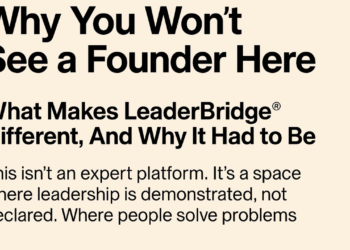Leadership doesn’t always grow in the ways we expect. It doesn’t always emerge in the classroom, the coaching session, or the team meeting. And it rarely comes from simply learning what to do. It comes from doing, reflecting, and trying again.
At its best, leadership isn’t just a role, it’s a practice. A discipline you study, cultivate, and deepen over time. Like yoga, music, or medicine, it evolves through repetition, feedback, and presence. It’s not mastered once. It’s practiced, again and again.
But outside of real-world responsibility, where do we actually practice leadership? Where do we rehearse the moments that matter, without the risk of failure or the noise of workplace politics?
LeaderBridge® offers a space to do just that, to engage in practice as action. To take on real challenges in a shared, structured environment designed for feedback, growth, and clarity.
We define practicing leadership as stepping into meaningful challenges, away from work, where the goal isn’t just solving the problem, but developing the capacity to lead better next time. And in that way, each session on LeaderBridge isn’t just practice, it becomes part of your broader leadership practice.
The LeaderBridge design seeks to leverage what actually works, and avoid what often doesn’t, in leadership growth programs. We looked closely at what derails development, status dynamics, vague models, one-way content, and we built around what enables it, the structure, feedback, shared challenge, and trust.
The result is a system of six interconnected design decisions. Each one either breaks from tradition, adds a deliberate twist, or makes a clear commitment to fully leverage what actually works. And one of them holds the key to all the others.
The 6 Variables That Make This Work
1. Anonymity (with Integrity)
This is the boldest move, and the one that changes everything. By stripping away names, bios, demographics, and credentials, we remove the social shortcuts that usually shape leadership interactions. We intentionally eliminate the cues people rely on to judge who matters. What’s left is only what matters:
– What is the problem?
– How do we approach it?
– What kind of leadership shows up in this moment?
But anonymity alone isn’t enough. It demands integrity, and that’s where verification comes in. Every user on LeaderBridge is verified before they engage, that means they subscribe. Currently, that’s $33/month for early adopters. It’s not just access. It’s a signal of intent. No bots. No observers. Just real people, stepping into real challenges, with real skin in the game.
This level of anonymity with integrity doesn’t exist anywhere else in leadership development. It’s fragile. It’s radical. It’s earned. And it changes the entire experience.
2. Peer-to-Peer Practice
No instructors. No hierarchies. No observers. Just two peers, shoulder-to-shoulder, each bringing effort, perspective, and vulnerability. It’s not top-down or bottom-up. It’s across.
That doesn’t mean there’s no expertise, far from it. Peers bring a wide range of experience to the table. But in this setting, no one gets to pull rank. Insight has to earn its way in through clarity, relevance, and presence, not credentials. That’s the shift. And it’s a powerful disruption to how leadership is usually taught.
3. Real Human Presence (Not Simulation)
There’s a moment in every great collaboration when you realize, “I know that you know. You know that I know. We both know we’re in this together.” That loop of mutual awareness is subtle, but it changes everything. It’s what turns two people into a team. It’s how trust forms quickly. It’s what makes the interaction feel real and alive.
LeaderBridge is built to support that moment, not simulate it. While AI can mimic insight and emotion, it can’t grow with you. It can’t sense your intent, adapt to your leadership, or recognize how far you’ve come. Only a human peer can do that. And that’s why every session on LeaderBridge is human-to-human by design.
4. Real-Time Interaction (with Purpose)
LeaderBridge doesn’t work asynchronously. It’s live, real-time leadership practice, focused on real challenges that matter now.
But real-time practice isn’t easy to orchestrate. It demands:
– A curated and committed user pool
– Tight filters and signals for availability
– A culture of readiness and energy
We built mechanisms to make real-time interaction possible and purposeful, not chaotic. This creates presence under pressure, the condition where leadership is actually forged.
5. Shared Feedback Becomes Insight
Feedback isn’t an add-on at the end. It’s built into the session itself. Throughout each practice, participants share focused, structured feedback, on themselves and each other. It happens in motion, not after the fact, giving people a clearer view of how they’re showing up in real time.
Each interaction becomes a mirror. Over time, those reflections become patterns:
– How you lead under pressure
– How others experience your presence
– What strengths show up consistently, and what gets in the way
It’s not abstract. It’s personal, visible, and cumulative. You don’t just grow, you see yourself growing, one interaction at a time.
6. The DOER-R Structure
Every practice session follows a simple, semi-structured rhythm:
– Define – What problem needs leadership?
– Own – Why is it yours to lead?
– Enlist – Who needs to be part of it?
– Resolve – What needs to happen next?
– Reinforce – What worked, and what needs to carry forward?
DOER-R standardizes the flow of leadership without scripting it. It leaves space for human variability while creating enough structure for deep collaboration. It’s flexible, focused, and real.
The Core Disruption: Leadership Without Identity
All six of these design choices are disruptive in their own right. But only one redefines what leadership development feels like, anonymity. When you remove identity, you remove the shortcuts we usually use to determine how much someone matters:
– What they’ve done
– Who they know
– What school they went to
– What company they work for
You also remove your own need to perform, to protect, to impress. What’s left is something rare, a leadership moment based entirely on interaction, not image.
That’s the hardest part to make work. Because anonymity only works when everything else does. Without identity to lean on, the structure has to carry the trust. If someone doesn’t show up, or the platform sets the wrong tone, there’s no safety net. Trust breaks. And the practice breaks with it. That’s why every other part of LeaderBridge exists, to support it, to protect it, to make it safe enough to be powerful.
This Is Why LeaderBridge Had to Be Different
LeaderBridge wasn’t designed to be slightly better training. It was designed to be something leadership development usually isn’t:
– Live
– Anonymous
– Peer-driven
– Structured
– Focused on the actual work of leading
We didn’t just tweak the old model. We broke it, and rebuilt it with practice at the center. It’s not the easiest way to grow. But for those ready for something real, it may be the most honest way to lead.
This piece builds on earlier reflections about trust, anonymity, and the kind of leadership development that actually transfers to real life.
LeaderBridge® is live now. Early adopters are already inside. If you’re ready to lead by doing, not just learning, you’re welcome to join us. (Link in comments.)


































